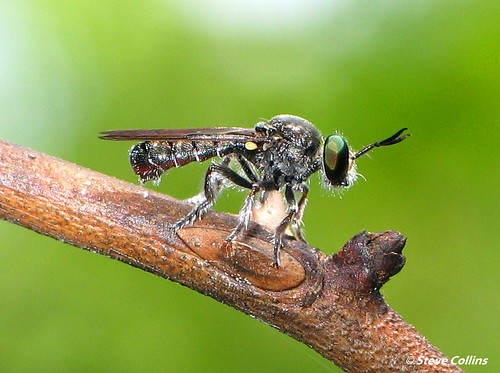Robber flies
(Cerotainia spp.)
Overview • Description • Distribution • Taxonomy
Two North American species are generally recognized, but the number of species in North America is a matter of debate. One species, Cerotainia macrocera, with brown eyes and black and white hairs, is relatively common in the eastern United States but rare in Canada. A second species, Cerotainia albipilosa, with green eyes and much more white hairs, is reported as common in Canada, but some consider it a color morph of Cerotainia macrocera, not a distinct species. A third species, Cerotainia atrata, has been described from a single specimen in Nebraska in 1907. It has never been found again, and the specimen is now classified as an unrecognized species. |
||
Description |
||
Cerotainia adults are black and 3 ⁄16″ to ⅜″ (5 to 9 mm) in length. The compound eyes are widely separated at the top. When viewed from the side the entire face protrudes beyond the eyes. The forehead (frons) is covered with long hairs. The antennae are relatively long. The first segment (scape) is four or more times as long as the second segment (pedicel). The wings are clear. They are smoky brown at the tip, becoming paler at the base. The first and second branches of the radial sector vein (R1 and R2+3) join before the end of R1 creating a closed cell that does not reach the margin. |
||
Distribution |
||||
|
Sources |
|||
| 6/18/2023 | ||||
Taxonomy |
|||
Order |
Diptera (Flies) | ||
Suborder |
Brachycera | ||
Infraorder |
Orthorrhapha | ||
Superfamily |
Asiloidea | ||
Family |
Asilidae (Robber Flies) | ||
Subfamily |
Laphriinae | ||
Tribe |
Atomosiini | ||
Subordinate Taxa |
|||
white-faced micropanther (Cerotainia albipilosa) |
|||
Synonyms |
|||
|
|||
Common Names |
|||
This genus has no common name. The common name of the family Asilidae is robber flies, and it is used here for convenience. |
|||
Glossary
Frons
The upper front part of an insect’s face, roughly corresponding to the forehead.
Scape
In plants: An erect, leafless stalk growing from the rootstock and supporting a flower or a flower cluster. In insects: The basal segment of the antenna.
Visitor Photos |
|||||
Share your photo of this insect. |
|||||
| This button not working for you? Simply email us at info@MinnesotaSeasons.com. Attach one or more photos and, if you like, a caption. |
|||||
Babette Kis |
|||||
Cerotainia sp. robberfly Cerotainia sp., robberfly, with prey, on Barnes Prairie, Racine Co., WI. Photographed on July 11, 2021. |
 |
||||
 |
 |
||||
MinnesotaSeasons.com Photos |
|||||
|
|||||

Visitor Videos |
|||
Share your video of this insect. |
|||
| This button not working for you? Simply email us at info@MinnesotaSeasons.com. Attach a video, a YouTube link, or a cloud storage link. |
|||
Other Videos |
|||

Visitor Sightings |
|||||
Report a sighting of this insect. |
|||||
| This button not working for you? Simply email us at info@MinnesotaSeasons.com. Be sure to include a location. |
|||||
| Babette Kis 7/11/2022 |
Location: Barnes Prairie, Racine Co., WI Cerotainia sp., robberfly, with prey, on Barnes Prairie, Racine Co., WI. Photographed on July 11, 2021. |
||||
MinnesotaSeasons.com Sightings |
|||||
|
|||||

Created: 6/18/2023
Last Updated:



